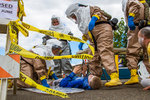
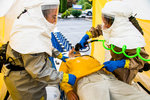
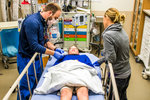
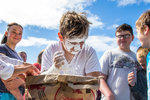
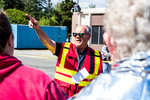

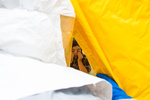
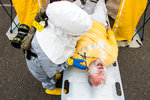
A dismal line of people, coated in white powder, coughing, wheezing and limping walked onto the Centralia Providence Hospital parking lot near the emergency room entrance Wednesday morning.
Thankfully, the powder was actually powdered sugar and the alarming side effects were only the symptoms of good acting.
The hospital is required to do two large-scale emergency drills per year, said Jon Kovarik, emergency preparedness coordinator for Providence’s southwest Washington service area. Wednesday’s events fulfilled one of those requirements — which, Kovarik said, may be substituted for actual large scale emergencies if one were to occur in the area.
Following the day’s activity, which was slated to last through the morning, everyone involved was set to gather and take stock of what went well and how things can improve.
“That’s really the point of all these exercises. There’s a lot of training involved, but it’s also to see where our gaps are. You don’t really know until you pull it all together,” said Kovarik.
Supervisors in bright vests watched the exercise take place, and took notes along the way.
Many of the actors were part of Scout Troop 373, and they coated themselves in white powder before being brought to the staging area in the parking lot. Chris Thomas, communications manager for the hospital, said most of the hospital’s staff wasn’t aware of the training until that morning. He said they need to tend to the important balance of taking care of actual patients — the top priority, he said — and taking part in the impromptu training.
The exercise affected hospital staff in the emergency center, emergency management, facility services, patient registration, security services and support services.
In the mock scenario, Thomas said a strange white powder was sent to an office building. The hospital was notified that a large number of patients were on their way, and so staff had to set up a decontamination area outside the building to prepare.
Kovarik gave the actors instructions. He told them to cough and wheeze, but gave six of them special instructions. Placards hung around the six’s necks with a longer list of symptoms. Some were unable to walk. Some were confused and uncooperative. Some couldn’t speak in full sentences.
Kaylee Ervin, with Troop 373, said her instructions said she had been trampled during the chaos and her arm was dislocated. She planned to keep it limp at her side.
Jacob Miess, with Troop 373, said he was to act disoriented and unable to respond inappropriately to commands. He said his plan was to simply stare at the hospital staff and only state that his legs hurt.
Members of the hospital staff were in the parking lot in suits that covered them from head to toe. They took the patients one at a time. Some patients couldn’t walk, and immediately started to lay on the ground when they got to the parking lot. They were loaded on stretchers and taken to tents where they were washed.
Kovarik said that in an actual decontamination situation, their clothes would be cut off and disposed of. For the purposes of the exercise, that step was left out.
Patients that could walk were taken to a tent where they were to shower, washing the powder off.
Thomas said in an emergency situation, they wouldn’t want anyone in the hospital to be affected by the substance, so the decontamination would need to occur outside.
Kovarik said coordinators may throw in complications — like if all the beds were full in the emergency department — if things are going too smoothly. It’s a balance of making things a challenge, but not impossible.
“You’ve got kind of a middle zone where you want to create a learning environment, test your plans and operations, but not make it so tough that people just kind of get discouraged. … The exercise stimulates, but doesn’t annihilate,” he said.
Miess was the first one in line. He was loaded up on a stretcher carried by multiple suited staffers and had the white powder washed off in a tent. They loaded him up onto a wheeled stretcher and took him into the emergency department.
A staff member gave him a blanket after he noted that apart from the training, he was actually pretty cold from the water. As a doctor started the examination, he asked him how he was feeling. Miess stuck to his strategy, telling the doctor over and over again that his legs hurt.
Thomas said many of the staff members may have just been seeing actual patients before tending to the fake ones. So it’s important for the actors to stay in character, he said, so the illusion of realism is continual throughout the day.